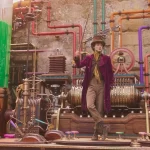A Monster Calls: Search and Destroy, by David Bax
It’s a shame we tend to assume that children won’t be able to handle works of art that upset us as adults. J.A. Bayona’s A Monster Calls concerns some heavy subject matter and is occasionally intense and scary to the point being a full blown horror movie but its subsequent PG-13 rating will likely keep it out of reach of far too many of the kids whose message it would probably help most. Part of its defining philosophy, in fact, is that the world can be unfair, senseless, dark and sad without regard for the age or delicacy of the people it blithely undoes. Yet A Monster Calls remains an optimistic film about growth, self-discovery and hope.
13-year-old Conor (Lewis MacDougall) is a quiet, creative only child to a single mother (Felicity Jones) who is terminally ill and likely in the final weeks of her life. This means Conor is faced with massive, cruel and unwanted changes in the near future. He’ll likely have to live with his prim, stern grandmother (Sigourney Weaver), whose meticulously appointed house has none of the warmth or life of the home he shares with his mother. He’d settle for living with his dad (Toby Kebbell) but he has a new family, lives in another country and has implied, gently but clearly, that he has no room for Conor fulltime. In the midst of this turmoil, Conor begins to receive nightly visits from a monster who spends his days as an ancient yew tree. The monster tells Conor stories from its centuries of existence. But once his tales are told, he warns, he will require Conor to tell him his story in return.
Each of the monster’s stories is illustrated via simple but gorgeous animation, recalling the tale of the Deathly Hallows in Harry Potter and the Deathly Hallows: Part 1. These fanciful sections stand as one end of Bayona’s visual spectrum. At the other is the bleak, overcast reality of Conor’s daily life. With the CGI monster and Conor’s many dreams and nightmares in between, A Monster Calls blurs the line between live action and animation like so many big-budget movies do these days but with more mindful intent than, say, this year’s “live action” version of The Jungle Book.
Bayona’s liberal use of CGI also allows Conor’s fantasies to play out in full force. Given the facts of his situation, so unimaginable and yet so sickeningly banal, these fantasies are ones of anger and destruction. A Monster Calls stands as perhaps the best and most approving depiction ever made of how much better you can make yourself feel just by smashing some things into pieces. It’s worth noting at this point just how much Bayona relies on MacDougall to channel raw emotions and how well the young actor does so without ever appearing to have a precocious hissyfit. Add to that the homosexual undercurrents of Conor’s interactions with the school bully and you’ve got a tall order for such a neophyte actor. Luckily, this kid is great.
Cathartic though Conor’s destruction (both real and imagined) may be, it’s not enough to inoculate him against the effects of his mother’s slow necrosis. As her condition worsens, her skin and lips lose their color but Bayona cleverly and subtly employs similar makeup tricks on the rest of the family as well. Weaver’s hair seems to deflate more and her wrinkles seem to spread further in each scene while Conor’s fitful sleep leads to increasingly pronounced bags under his young eyes. Death is hard on the dying but in many ways, A Monster Calls argues, it’s hard on those around them too, as they become equally vigilant and helpless.
For these reasons and others, death is as much a mercy as a tragedy. That’s a complex idea for a young mind but A Monster Calls doesn’t stop there. Through his stories, the monster demonstrates again and again that truth, belief and emotion can and do exist in simultaneous contradiction to themselves. Not only are children able to process such notions, they ought to. A Monster Calls offers a potent, uncondescending yet safe venue for them to do so.





























